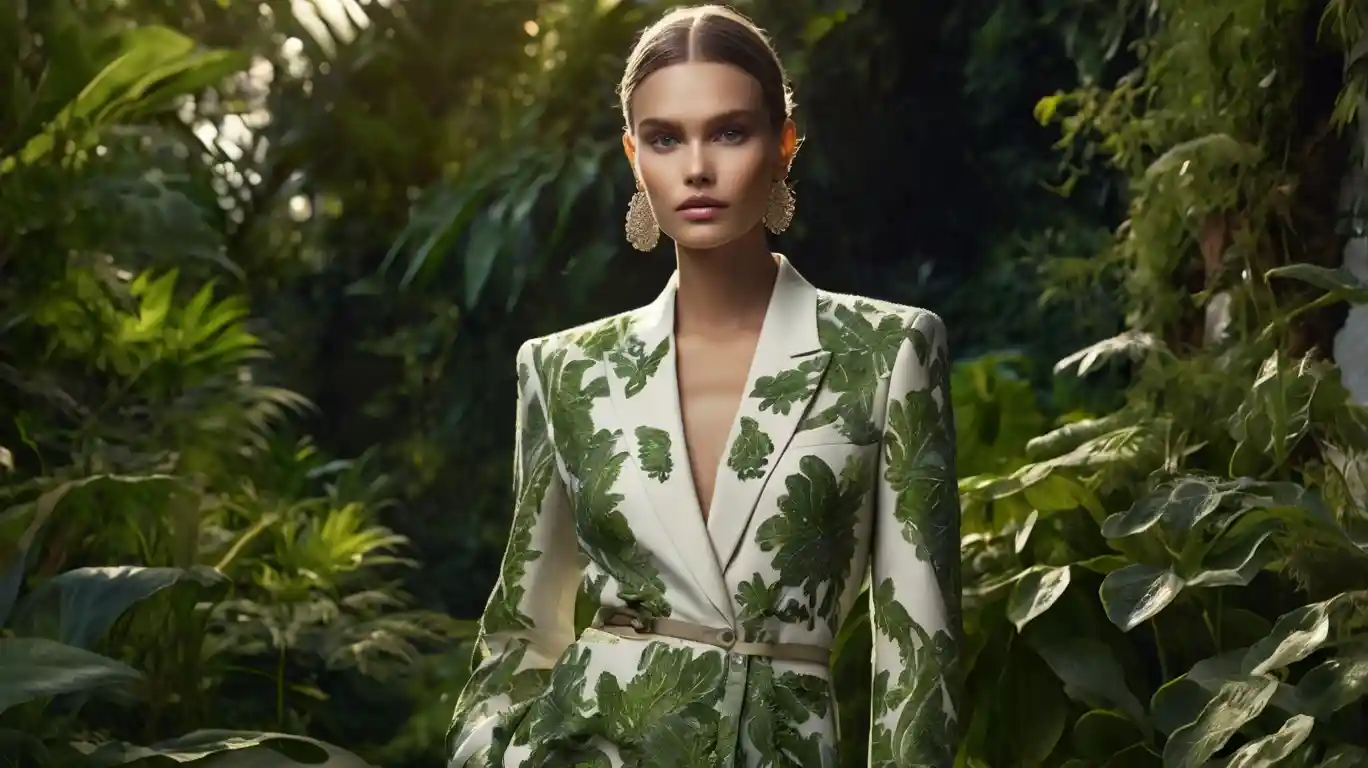In an industry traditionally defined by opulence and excess, a remarkable metamorphosis is underway. Sustainable Luxury Fashion—once the poster child for conspicuous consumption—is experiencing a profound philosophical shift as sustainability transforms from peripheral concern to core value.
This isn’t merely greenwashing or clever marketing; it’s a fundamental reimagining of what luxury means in our resource-constrained world.
Today’s discerning consumer demands more than exquisite craftsmanship and exclusive design; they expect responsible sourcing, ethical production, and environmental stewardship as non-negotiable elements of true luxury.
The marriage of sustainability and luxury, once considered paradoxical, now represents fashion’s most exciting frontier. Leading houses are discovering that environmental consciousness doesn’t dilute luxury’s allure—it enhances it.
Through innovative materials, transparent supply chains, regenerative practices, and bold climate commitments, these brands are proving that responsibility and opulence can coexist beautifully. Their pioneering work isn’t just reshaping wardrobes; it’s redefining an entire industry.
Contents
Introduction to Sustainable Luxury
What is Sustainable Luxury Fashion?
Sustainable luxury fashion exists at the intersection of opulence and responsibility—a concept that would have seemed contradictory a mere decade ago.
At its core, it encompasses luxury fashion that considers the entire lifecycle of each garment, from ethical material sourcing to environmentally conscious production processes, and ultimately, the item’s longevity and eventual recycling or biodegradation.
Unlike fast fashion’s disposable ethos, sustainable luxury embraces durability and timelessness as ultimate expressions of exclusivity.
What distinguishes sustainable luxury from merely “eco-friendly” fashion is its uncompromising commitment to excellence. These brands demonstrate that sustainability need not involve aesthetic or quality sacrifices.
Rather, environmental responsibility becomes another dimension of craftsmanship—another expression of the meticulous attention to detail that has always defined luxury.
The artisanal techniques preserved by luxury houses—hand-stitching, small-batch production, made-to-order models—often intrinsically align with sustainability by reducing waste and energy consumption while preserving irreplaceable human skills.

Top Sustainable Luxury Brands
Stella McCartney
When discussing sustainable luxury fashion, Stella McCartney invariably leads the conversation as the industry’s environmental pioneer. Since founding her eponymous label in 2001 with a steadfast commitment to cruelty-free fashion, McCartney has transformed what many considered limitations—no leather, no fur, no feathers—into catalysts for unprecedented innovation.
What once seemed radical in luxury circles now appears prescient as the industry races to catch up with her visionary approach.
McCartney’s material innovation achievements stand unparalleled in luxury fashion. The brand has developed regenerated cashmere that reduces environmental impact by 92% compared to virgin cashmere, revolutionary econyl fabric crafted from recycled plastic bottles recovered from oceans, and sustainable viscose sourced exclusively from certified, responsibly managed forests.
Perhaps most groundbreaking is McCartney’s development of Mylo™ mushroom leather—a biodegradable alternative to animal leather made from fungal mycelium that offers luxury’s aesthetic and performance qualities without ethical concerns.
Chanel
The iconic house of Chanel—synonymous with timeless elegance through its interlocking Cs and tweed jackets—has quietly implemented one of luxury fashion’s most comprehensive environmental strategies. This transformation demonstrates that even fashion’s most established institutions can embrace meaningful change without compromising their heritage or design identity.
Chanel has structured its sustainability approach around four ambitious actions directly addressing its environmental footprint. The company has committed to reducing the carbon footprint of operations by 50% and from its value chain by 40%—targets that demonstrate serious climate ambition from a global luxury leader.
Already achieving 97% renewable energy across its operations, Chanel is on track to reach 100% by 2025.This transition represents a significant investment for a brand with extensive manufacturing facilities and a global retail network spanning dozens of countries.
Transportation accounts for approximately 20% of Chanel’s carbon footprint, prompting innovative solutions across its logistics infrastructure. The brand has increased electric vehicle deployment for daily deliveries, strategically shifted from air to sea freight when feasible, and restructured air shipping to prioritize routes and carriers producing less CO2. These changes save an estimated 10,000 tonnes of carbon emissions annually—a material improvement rather than a symbolic gesture.
Louis Vuitton
The storied house of Louis Vuitton—instantly recognizable by its monogrammed leather goods and global luxury presence—has transformed its approach to sustainability through the ambitious LVMH LIFE 360 programme. Launched in 2021, this environmental plan establishes clear deadlines (2023, 2026, and 2030) and structures initiatives around four essential pillars: biodiversity, climate, creative circularity, and traceability.
Louis Vuitton’s climate commitments have received validation from the Science-Based Targets initiative (SBTi), underscoring their credibility and ambition. The brand has committed to reducing its direct carbon footprint by 55% by 2030, alongside significant reductions in supply chain emissions.
These aren’t aspirational targets but carefully calculated goals based on climate science and detailed carbon accounting across the company’s operations.
The brand’s shorter-term roadmap, “Our Committed Journey,” establishes quantified objectives to be reached by 2025, with particular emphasis on biodiversity preservation.
Louis Vuitton’s partnership with conservation charity People for Wildlife maintains and improves biodiversity across 400,000 hectares in Australia—an area roughly twice the size of London. This vast conservation project illustrates how luxury brands can support environmental protection at landscape scale rather than through tokenistic initiatives.
Gabriela Hearst
Gabriela Hearst represents a new generation of luxury designers for whom sustainability isn’t an afterthought but a founding principle. Her eponymous brand has redefined luxury through radically transparent production and revolutionary material choices, earning recognition as one of sustainable fashion’s most sophisticated innovators.
Hearst’s dedication to eliminating virgin materials sets a new benchmark for resource consciousness in luxury. Her collections feature recycled cashmere, deadstock fabrics, and aloe-treated linen, demonstrating how sustainable materials can enhance rather than compromise luxury quality.
Perhaps most impressive is Hearst’s commitment to carbon neutrality, extending even to her runway shows—traditionally among fashion’s most excessive and wasteful marketing events
In a 2019 interview that revealed fashion’s ambivalence toward sustainability messaging, Hearst recounted industry warnings against emphasizing her environmental commitments.
Her response was unequivocal: “People tell me, ‘Oh you shouldn’t talk so much about sustainability.’ But for me, personally, there’s no other pressing thing happening in the world” This conviction has proven prescient as sustainability evolved from niche concern to central luxury value.
Prada Group
The Prada Group, under the creative direction of Miuccia Prada and now co-creative director Raf Simons, has transformed from a traditional luxury house into a sustainability pioneer without sacrificing its intellectual, boundary-pushing aesthetic.
The Italian powerhouse approaches sustainability with characteristic thoughtfulness, developing comprehensive strategies that address multiple environmental concerns simultaneously.
Prada’s sustainability journey began formally a decade ago with its first sustainability report, but the company significantly accelerated its commitments by publishing a dedicated sustainability policy in 2019.
By 2021, the Group had submitted its greenhouse gas emissions reduction targets to the Science Based Targets initiative (SBTi) for approval, demonstrating commitment to measurable, verified progress rather than vague aspirations
Gucci
Gucci, under the creative direction previously of Alessandro Michele and now Sabato De Sarno, has transformed from a traditional luxury house into a sustainability leader while maintaining its distinctive maximalist aesthetic appeal.
The Italian brand’s Equilibrium initiative represents one of luxury fashion’s most comprehensive sustainability programs, addressing environmental and social impacts across the entire value chain.
The Equilibrium program incorporates sustainable raw materials, eco-friendly dyes, and biodegradable packaging—demonstrating that sustainability can extend to every aspect of luxury production
Gucci has committed to reducing its carbon footprint and championing ethical labor practices throughout its supply chain, recognizing that true sustainability encompasses both environmental and human welfare.
What distinguishes Gucci’s approach is its unprecedented transparency. The brand has made bold commitments to supply chain visibility, allowing consumers to understand the journey of materials from source to finished product.
This transparency—once anathema in the secretive world of luxury fashion—represents a radical shift in how luxury brands communicate with increasingly conscious consumers
Patagonia
Patagonia occupies a unique position in sustainable luxury fashion. Though primarily known as an outdoor apparel company, Patagonia has successfully integrated sustainable principles into the luxury segment by championing slow fashion and exceptional quality that transcends seasonal trends.
The brand’s unwavering commitment to environmental activism sets it apart even among sustainability leaders.
Patagonia’s approach centers on producing long-lasting, repairable clothing using recycled and organic materials This focus on durability directly counters disposability prevalent in fashion, even at luxury price points.
By creating garments designed to last decades rather than seasons, Patagonia embodies sustainability’s most fundamental principle: reducing consumption through quality and longevity.
Environmental activism distinguishes Patagonia from virtually every other brand operating at premium price points. The company donates a percentage of its profits to environmental causes, directly funding conservation and restoration projects worldwide
This commitment extends beyond financial contributions to include advocacy campaigns addressing climate change, biodiversity loss, and environmental policy—using the brand’s platform to drive systemic change beyond its own operations.
Vivienne Westwood
Vivienne Westwood—the legendary queen of punk fashion—has channeled her rebellious spirit into environmental activism, creating a brand that merges bold design with radical sustainability.
Westwood has long used her platform to challenge consumption patterns and raise awareness about environmental issues, making sustainability central to her brand identity rather than a peripheral concern.
The Westwood brand advocates for ethical sourcing, upcycling, and organic fabrics. Rather than viewing these practices as constraints, Westwood embraces them as creative opportunities, demonstrating how sustainable principles can fuel rather than limit design innovation.
The brand has integrated waste-reduction strategies throughout its production processes, proving that high fashion can be both luxurious and environmentally responsible<.
Westwood herself has become fashion’s most outspoken environmental advocate, famously declaring “Buy less, choose well, make it last.” This philosophy directly challenges the consumption-driven business model that dominates fashion, even as Westwood continues to create desirable luxury products. This apparent contradiction reflects the complex reality of sustainable fashion—creating products while simultaneously questioning overconsumption.
Mara Hoffman
Mara Hoffman founded her eponymous label in 2000 after graduating from Parsons School of Design, initially gaining recognition for vibrant prints and resort wear. However, in 2015, Hoffman initiated a profound brand transformation, pivoting toward sustainability without sacrificing her distinctive aesthetic sensibility.
What distinguishes Hoffman in the sustainable luxury landscape is her comprehensive approach to material selection. The brand utilizes organic cotton, recycled polyester, and Tencel™ Lyocell—a fiber derived from sustainably harvested wood pulp.
These material choices significantly reduce water usage, chemical inputs, and carbon emissions compared to conventional alternatives, demonstrating how thoughtful sourcing can drastically reduce fashion’s environmental footprint.
Hoffman has implemented a circularity program called Full Circle, which accepts worn Mara Hoffman garments for resale or recycling. This initiative addresses fashion’s end-of-life challenges, ensuring that garments don’t end their journey in landfills.
By taking responsibility for products throughout their entire lifecycle, Hoffman extends sustainability beyond production to encompass consumption and disposal—a truly holistic approach to environmental responsibility.
Nanushka
Founded in 2006 by London College of Fashion graduate Sandra Sandor, Budapest-based Nanushka has rapidly established itself as a leader in contemporary sustainable luxury. The brand masterfully blends Eastern European design influences with a global perspective, creating distinctive garments that appeal to fashion-forward consumers while maintaining strong environmental values.
Nanushka has gained particular recognition for its innovative vegan leather alternatives, which offer the luxurious hand-feel and visual appeal of animal leather without the ethical and environmental concerns.
The brand’s vegan leather pieces—particularly its puffer jackets and tailored vests—have achieved cult status among fashion influencers, demonstrating how sustainable materials can drive rather than detract from desirability.
Material innovation extends beyond leather alternatives to include organic cotton, recycled cashmere, and regenerated materials throughout Nanushka’s collections. The brand approaches sustainability as an ongoing journey rather than a fixed destination, continuously researching and implementing new materials and processes to reduce environmental impact while maintaining its distinctive aesthetic.
Emerging Trends in Sustainable Luxury
Future of Sustainable Luxury Fashion
As we look toward sustainable luxury’s horizon, several emerging trends promise to reshape the industry’s relationship with environmental and social responsibility. These developments extend beyond incremental improvements to envision fundamentally new models for creating, distributing, and experiencing luxury fashion—transformations that will redefine what luxury means by 2025 and beyond.
Material innovation represents perhaps the most exciting frontier in sustainable luxury. Brands are investing heavily in next-generation sustainable materials that match or exceed the performance and aesthetic qualities of conventional luxury materials. Mylo™ mushroom leather, grape-based vegan leather, and regenerated ocean plastics are just the beginning.
Research into lab-grown leather and silk—materials biologically identical to animal products but produced without animal involvement—could revolutionize luxury accessories. These innovations promise to resolve the tension between traditional luxury materials and sustainability concerns, creating guilt-free alternatives that sacrifice nothing in quality or beauty.
Circular business models are gaining traction across the luxury segment, extending beyond materials to encompass entirely new ownership concepts. Rental, resale, and restoration services are increasingly integrated into luxury brands’ core offerings rather than relegated to third-party platforms.
Brands like Gucci and Burberry have launched their own authenticated resale platforms, recognizing that circularity represents not a threat but an opportunity to engage consumers throughout multiple product lifecycles. This shift from linear to circular models fundamentally challenges the notion that luxury requires constant newness.
Conclusion
The transformation of luxury fashion toward sustainability represents more than an industry trend—it reflects a fundamental reevaluation of what luxury means in our resource-constrained world.
The ten brands profiled here demonstrate that environmental responsibility and social consciousness can enhance rather than compromise luxury’s core values of exceptional quality, craftsmanship, and design excellence.
What unites these diverse approaches to sustainable luxury is a willingness to question fashion’s established practices and reimagine luxury from first principles. From Stella McCartney’s pioneering animal-free designs to Chanel’s comprehensive climate strategy, from Patagonia’s environmental activism to Nanushka’s material innovations, these brands are writing a new chapter in luxury’s history—one defined by responsibility as much as exclusivity.
For discerning consumers, these brands offer a powerful opportunity to align personal values with aesthetic desires. By supporting sustainable luxury brands, fashion enthusiasts can drive industry-wide change while enjoying beautiful garments created with integrity.
Every purchase becomes a vote for the future of fashion—one where environmental stewardship and human welfare are non-negotiable elements of true luxury.


